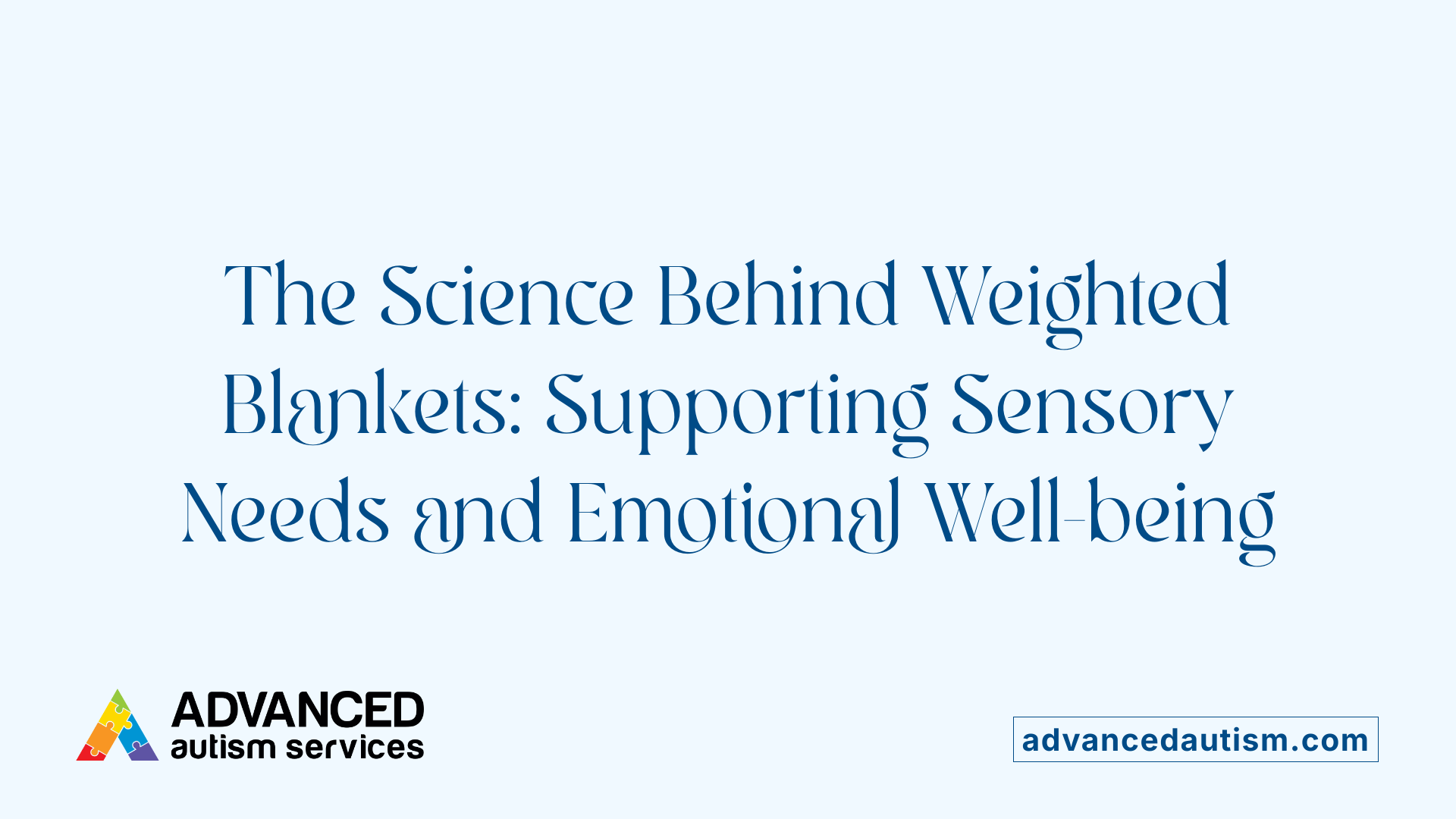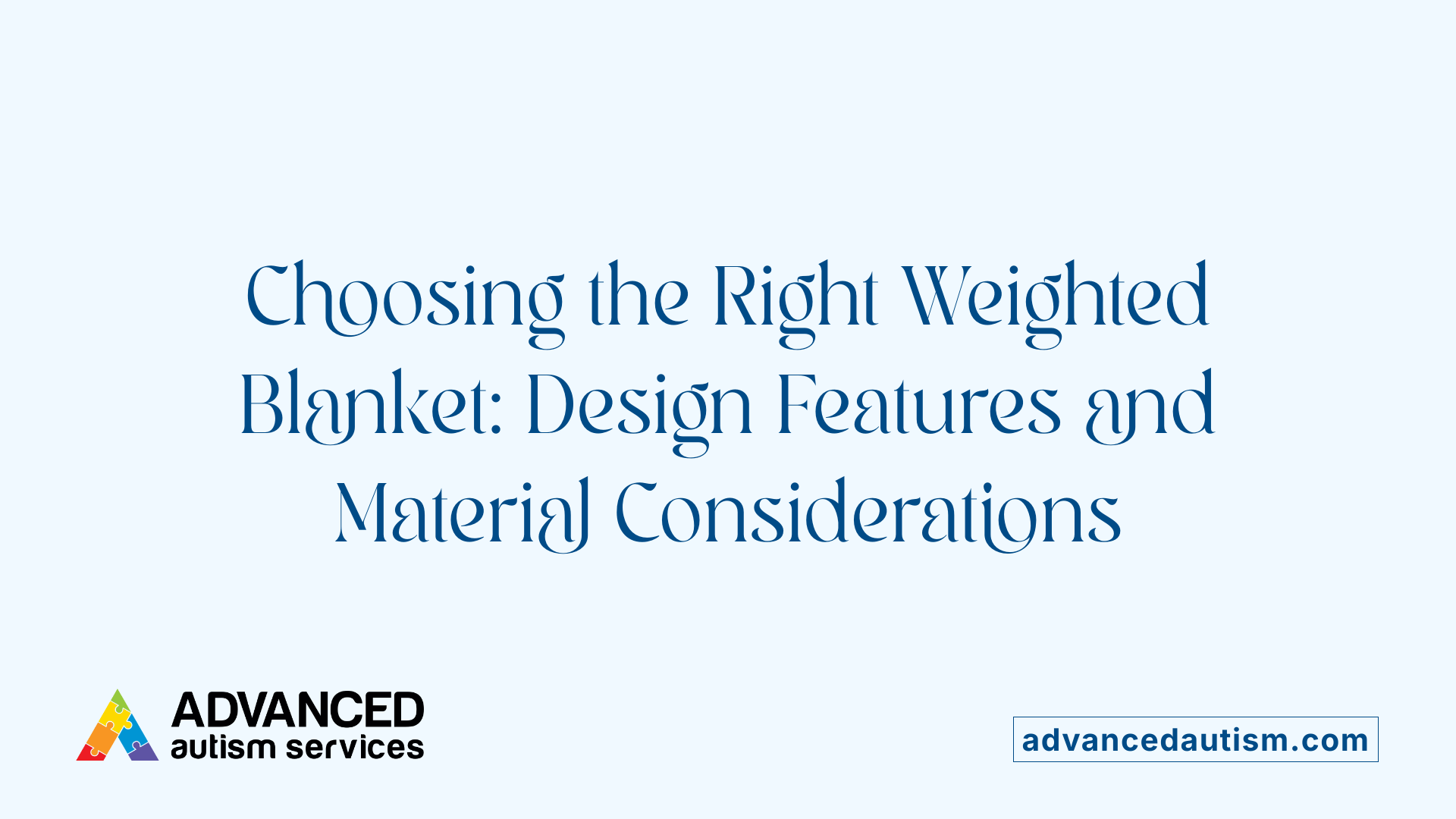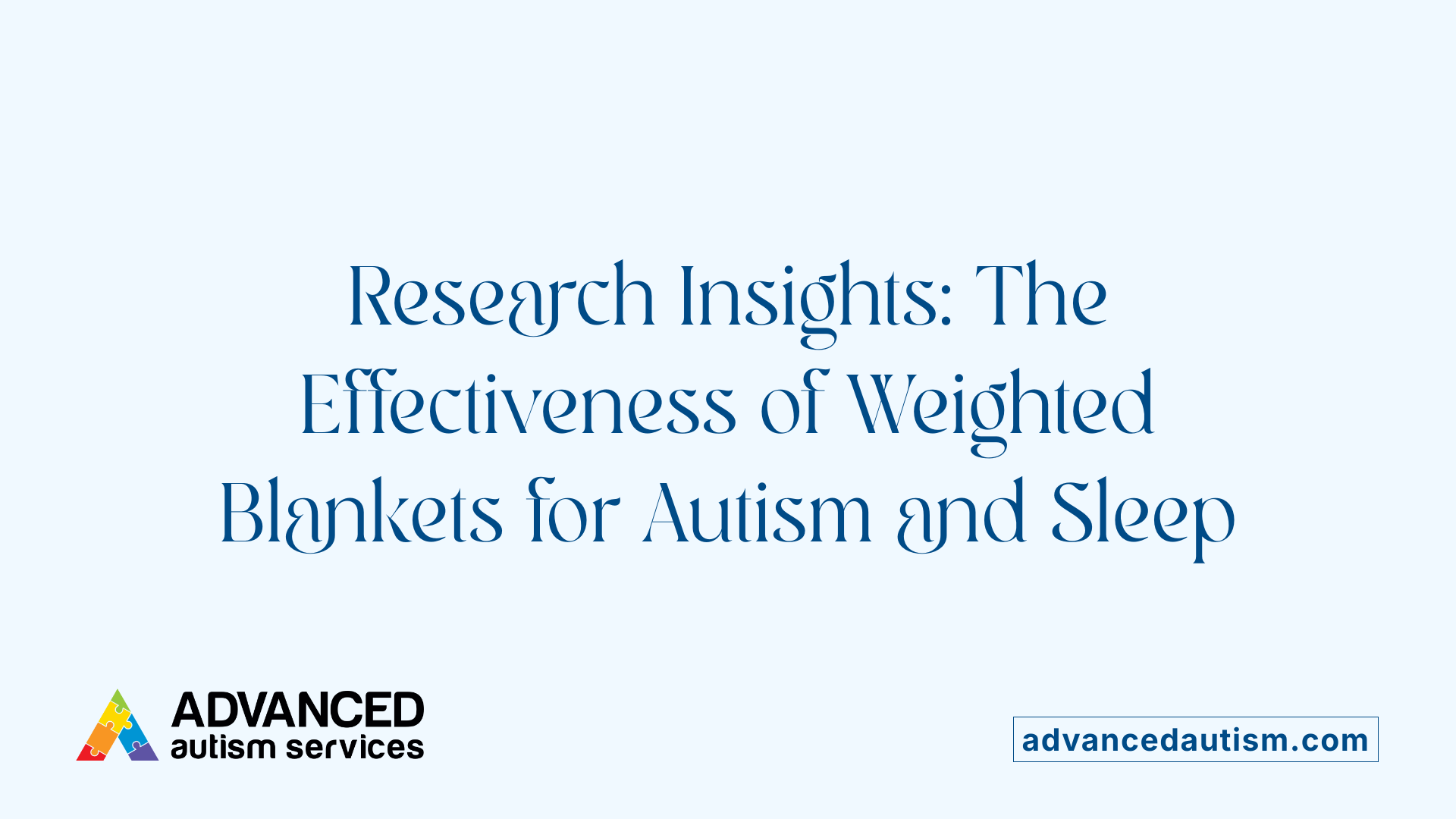Understanding the Therapeutic Role of Weighted Blankets in Autism Support
Weighted blankets have gained recognition as a supportive tool for individuals with autism, promoting relaxation, improving sleep, and managing sensory sensitivities. Their utilization spans therapeutic settings like clinics and schools to home environments, offering a non-invasive, holistic approach to calming and sensory regulation.
The Why and How of Deep Pressure Stimulation

How do weighted blankets work to support children with autism and sensory processing needs?
Weighted blankets are specially designed to provide deep pressure touch stimulation, which is a therapeutic approach grounded in sensory integration theory. When a child with autism uses a weighted blanket, the evenly distributed weight—often about 10-20% of their body weight—applies gentle, firm pressure over the body.
This deep pressure activates the proprioceptive system, which is responsible for sensing body position and movement. By stimulating this system, weighted blankets promote a calming and grounding sensation that helps to regulate the nervous system. The tactile input mimics the sensation of being hugged or held, which can significantly reduce feelings of anxiety and sensory overload.
Research indicates that this deep pressure stimulation can help lessen self-stimulatory behaviors and sensory sensitivities, making it easier for children to relax and focus. The calming effect is partly due to increased release of neurotransmitters like serotonin and oxytocin, chemicals associated with mood stabilization and relaxation. This process not only eases immediate discomfort but may also improve sleep quality and overall emotional stability.
Weighted blankets are made with materials such as glass beads or cotton fillings inside quilted pockets to ensure even weight distribution. Proper sizing and weight are crucial for safety; experts typically recommend selecting a blanket that weighs around 10% of the user's body weight. Additionally, safety features like the ability to remove the blanket easily are important, especially for children who may need to adjust or remove it to manage sensory input.
While the scientific evidence supporting their effectiveness is promising, it remains mixed. Many occupational therapists recommend weighted blankets as a complementary tool for sensory regulation, alongside tailored behavioral strategies. When used appropriately, they can serve as a holistic approach to support children with autism in managing anxiety, improving sleep, and achieving a sense of calmness.
Design Features and Material Choices for Comfort and Safety

What factors should be considered when choosing a weighted blanket for autism?
Selecting the right weighted blanket for autism involves several important considerations to ensure safety, comfort, and effectiveness. First, the weight of the blanket should typically be about 10% of the user's body weight, which helps provide the soothing deep pressure without feeling too heavy or restrictive.
Safety is paramount. The blanket must be designed so that the individual can easily remove it independently in case of discomfort or emergency. Additionally, the materials used should be non-toxic, avoiding fillings like lead, which can be hazardous.
Comfort plays a vital role, especially for those with sensory sensitivities. Fabrics that are breathable and soft, like organic cotton, help prevent overheating and skin irritation. The texture should match the user's preferences—some may prefer smooth or stretchy fabrics, while others may tolerate quilted textures.
Design features such as neck cut outs can further improve comfort by reducing pressure on sensitive areas and allowing better airflow. Size options must accommodate both sleep and daytime use, providing enough coverage while remaining manageable.
Involving a healthcare professional, such as an occupational therapist, can guide the choice of size, weight, and material, tailored to individual sensory needs and health considerations. Extra features like washable fabrics and adjustable components can also extend the blanket's usability and comfort.
Overall, prioritizing safety, sensory comfort, and appropriate sizing ensures the weighted blanket provides a calming effect without causing discomfort or safety issues.
Scientific Research Supporting the Use of Weighted Blankets

What scientific evidence exists regarding the effectiveness of weighted blankets for autism and sleep improvement?
Research on weighted blankets for autism and sleep enhancement offers a mix of promising findings and existing limitations. Several studies suggest that these blankets can be beneficial in reducing anxiety and promoting relaxation through deep pressure stimulation, which mimics the calming sensation of being hugged or held. For instance, a 2015 study involving adults in inpatient mental health settings found a 60% reduction in anxiety levels when using weighted blankets.
However, evidence directly linking weighted blankets to significant improvements in sleep quality in children with autism remains inconclusive. A 2014 randomized controlled trial with autistic children showed that, while total sleep time did not notably change, children expressed a preference for the blankets, and parents observed improvements in perceived sleep quality. A later systematic review from 2020 highlighted potential benefits for anxiety but noted that evidence for sleep enhancement is mixed and limited.
Research involving both children and adults with autism has shown that weighted blankets can help with falling asleep faster, maintaining sleep, and easing morning routines. A 2021 retrospective study indicated improvements in sleep onset, sleep duration, and daytime relaxation, though the results were not consistently strong enough to recommend blanket use as a clinical intervention.
Meta-analyses of trials in psychiatric populations underscore that weighted blankets can significantly reduce anxiety symptoms, which may indirectly support better sleep. Still, high-quality, large-scale research specifically targeting individuals with autism is scarce. The current understanding suggests that while many users find weighted blankets helpful for anxiety and relaxation, scientists agree more rigorous studies are necessary to conclusively prove their effectiveness for sleep improvements.
In summary, existing scientific evidence points toward potential benefits of weighted blankets in alleviating anxiety and promoting calmness in individuals with autism. However, the research on sleep quality enhancement needs further development, and conclusions should be cautiously drawn until more definitive studies are available.
Safe and Effective Use: Guidelines for Caregivers and Parents

How can parents and caregivers safely use weighted blankets for children with autism?
Using weighted blankets safely involves careful consideration of weight, safety features, and monitoring. Firstly, it's recommended that the blanket weighs about 10-20% of the child's body weight. For example, a child weighing 30 pounds would use a blanket around 3 to 6 pounds. This balance ensures the calming deep pressure without causing discomfort or restriction.
Parents should choose blankets that allow the child to easily remove them independently. This is critical for safety, as children must be able to stop using the blanket if they feel overwhelmed or need to change position.
Monitoring during use is essential. Watch for any signs of distress, discomfort, or allergic reactions. If the child shows signs of sensory overload or if the blanket seems too heavy or tight, remove it immediately.
It's important to avoid using weighted blankets with children under 2 years old, as they are at a higher risk of suffocation or injury. Additionally, consult a healthcare professional before introducing a weighted blanket, especially if the child has medical conditions like asthma, circulation problems, or sleep apnea.
Never cover the child's face with the blanket, and ensure the blanket is made of safe, non-toxic materials like organic cotton or fabrics free from harmful chemicals. Proper use and supervision can help maximize the benefits of deep pressure therapy while maintaining safety.
In summary, adhering to weight guidelines, choosing suitable blankets, observing the child closely, and seeking medical advice when needed are vital steps for safe and effective use of weighted blankets for children with autism.
Autism, Sensory Processing, and the Psychological Benefits of Weighted Objects
Why do many autistic individuals find weighted objects soothing?
Many autistic individuals find weighted objects, such as weighted blankets, to be incredibly calming. This comfort largely stems from the deep pressure stimulation these items provide. When a weighted blanket is draped over the body, it applies gentle, evenly distributed pressure, which acts as a form of deep touch therapy.
This pressure has a grounding and calming effect on the nervous system. It helps regulate brain chemicals like serotonin, dopamine, and oxytocin—neurotransmitters linked to feelings of happiness, relaxation, and emotional stability. As a result, many autistic people experience reduced anxiety and a greater sense of safety when using weighted objects.
The sensation of consistent, gentle pressure mimics the comforting feeling of being hugged or held. This can be especially helpful during sensory overload situations or routine changes, where feelings of overstimulation are common. The calming effect not only reduces immediate stress but can also improve sleep quality.
In addition, weighted objects can help those with hypersensitivities to touch. The pressure offers predictable and controlled sensory input, which can diminish hypersensitivity reactions and promote focus. Because of these benefits, many occupational therapists recommend weighted blankets and similar items as part of sensory integration strategies.
While they are not a cure, weighted objects serve as a valuable calming tool for many autistic individuals. They support emotional regulation, reduce stress, and foster a sense of security, making them a popular choice in both clinical and home settings.
The Broader Perspective: Weighted Blankets as Part of a Sensory Integration Strategy
Integration with other therapies and tools
Weighted blankets are often used alongside other sensory integration techniques and therapeutic approaches. Occupational therapists commonly recommend them to help children and adults with autism manage sensory needs. These blankets work best as part of a holistic plan that includes other tools like sensory diets, calming strategies, and behavioral therapies.
Personalized approaches based on individual needs
Since sensory preferences vary widely among individuals with autism, personalized use of weighted blankets is essential. Factors such as the person's age, size, sensory sensitivities, and personal comfort should guide the choice of blanket size, weight, and fabric. For example, some may prefer soft, organic cotton, while others might find certain textures overwhelming. Proper assessment by healthcare professionals can help tailor the use effectively.
Limitations and the need for professional guidance
While many report benefits, weighted blankets are not suitable for everyone. Young children under two years old and those with certain health conditions should avoid them unless supervised by a healthcare provider. It's important to ensure the blanket's weight (usually about 10-15% of body weight) is appropriate and that users can remove it independently for safety.
Though research supports their use for reducing anxiety and improving sleep, results can vary. Consulting with occupational therapists or medical professionals ensures safe, effective application within a broader sensory regulation strategy.
Conclusion: Embracing a Holistic Approach to Autism Support and Well-being
Weighted blankets are increasingly recognized as a valuable tool for supporting individuals with autism. Their primary benefit lies in providing deep pressure therapy, which can help reduce anxiety, improve sleep, and promote relaxation. Many users experience a calming effect similar to being hugged or held, which can be especially beneficial for those with sensory sensitivities.
The choice of a weighted blanket should be carefully tailored to individual needs. Proper selection involves considering the appropriate weight—generally about 10% of the person’s body weight—and choosing breathable, non-toxic materials like organic cotton filled with glass beads or cotton. These features ensure safety and comfort while delivering consistent deep pressure that supports regulation and relaxation.
Using weighted blankets as part of a broader, personalized strategy can enhance their effectiveness. Consultation with healthcare professionals, such as occupational therapists, can help determine suitability and ensure safe, effective use. It’s important for caregivers to observe how the individual responds to the blanket, adjusting as needed or exploring other support options.
While research continues to explore their full potential, existing studies support their use for some autistic individuals—particularly in improving sleep quality and reducing anxiety. When incorporated thoughtfully into a comprehensive approach, weighted blankets can be a calming, holistic addition that enhances overall well-being and sensory regulation for many.
Empowering Autism Support Through Calming Tools
Weighted blankets offer a promising, non-invasive approach to supporting individuals with autism, helping improve sleep, reduce anxiety, and enhance emotional regulation. Proper selection, safety considerations, and understanding each person's unique sensory profile are key to maximizing benefits. When integrated with other therapeutic strategies, weighted blankets can be a valuable component of a holistic approach to fostering calm, stability, and well-being in autistic individuals.
References
- Weighted Blankets for Autism & Sensory Needs
- A Weighted Blanket for Autism: The Ultimate Guide
- Weighted Blankets: Benefits, Do They Work, and More - Healthline
- Weighted Blanket and Autism: Benefits, Effects, and Research
- Weighted Blankets and Autism
- Are Weighted Blankets Beneficial for Autistic Children? - NAPA Center
- The effectiveness of weighted blankets on sleep and everyday ...
- The Actual Truth About Weighted Blankets for Autism - Karmara



